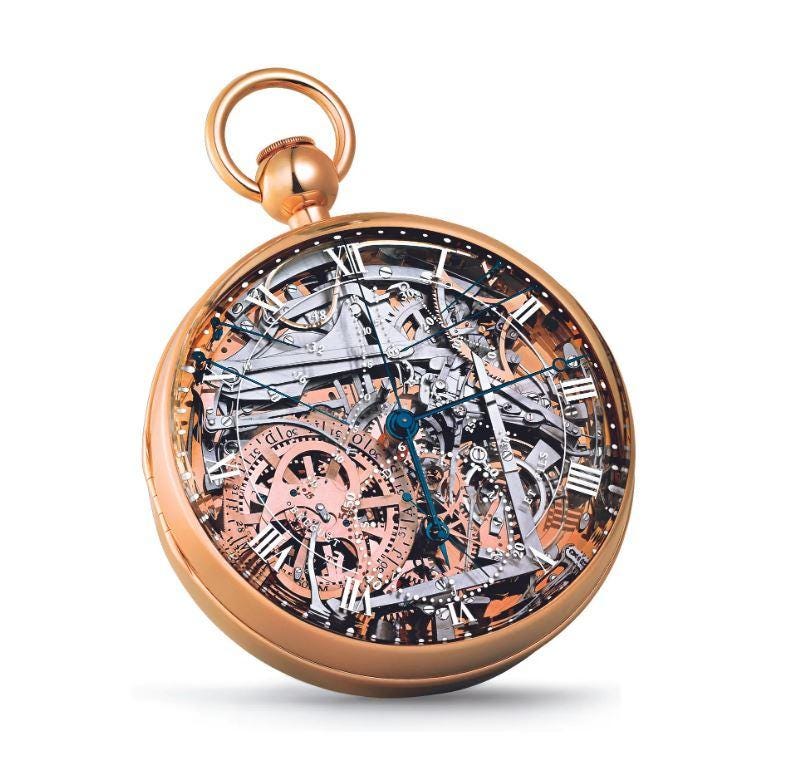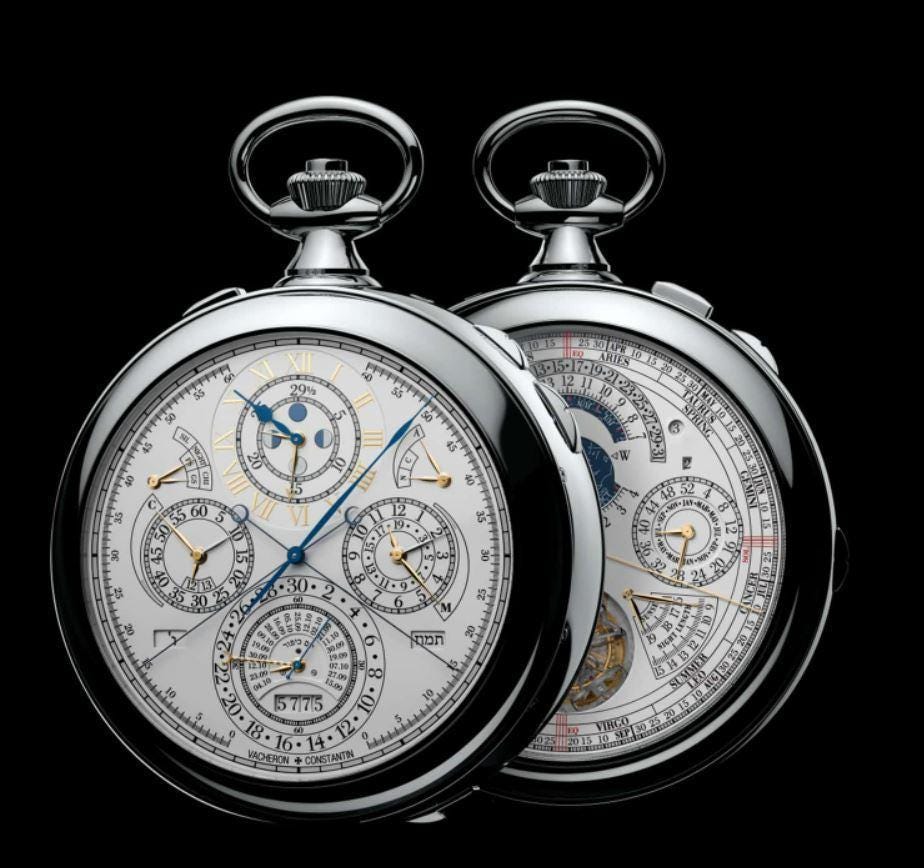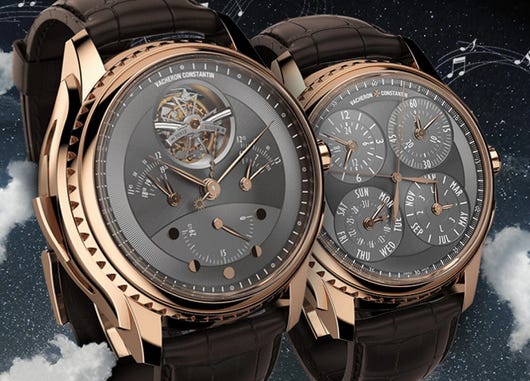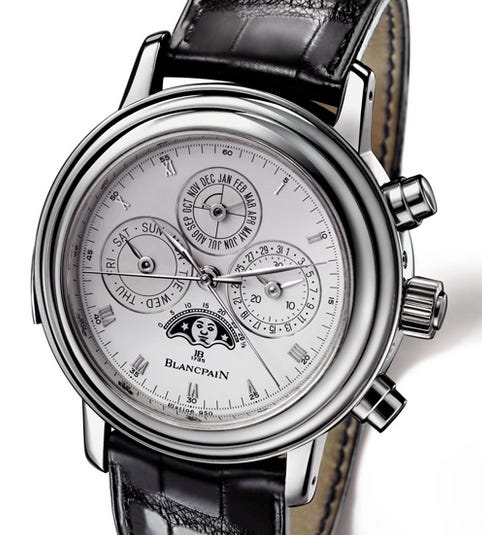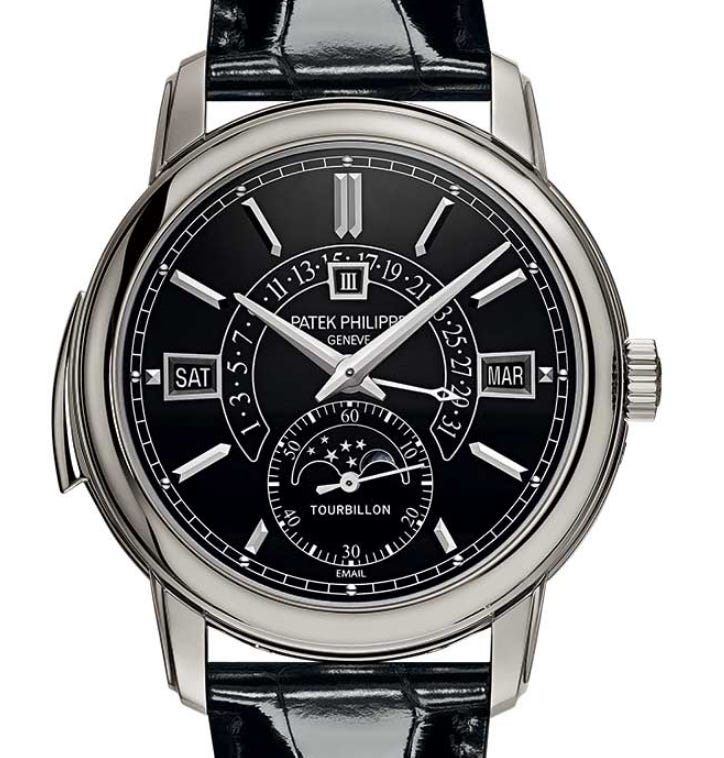The fascinating world of grand horological complications
An introduction to grand horological complications and their place in the history of Haute Horlogerie.
The history of grand complications begins with the “Marie-Antoinette”, one of the most notorious pocket watches in haute horlogèrie (see Fig. 1). Its notoriety comes from being a grand horological complication, the first of its kind, created for Queen Marie-Antoinette by the great master watchmaker Abraham Louis Breguet.
Queen Marie-Antoinette took pleasure in surrounding herself with luxury. She commissioned the grand complication herself from Breguet, with the requirement that it needed to be as spectacular as possible. Other historical accounts tell us that it was her lover Count Hans Axel von Fersen (1755-1810), a Swedish officer stationed at court, who commissioned the watch from Breguet. The instructions from Count von Fersen were to create a watch that should impress a woman who already had everything.
No expenses were spared to build the “Marie-Antoinette”. The watch was completed in 1827, 44 years after having been commissioned in 1783. It included 23 different complications and became the most complicated pocket watch in the world.
Fig. 1 - The “Marie-Antoinette”
What is a grand complication?
To understand what a Grand Complication is, we must first explain what a horological complication is: any additional function that a watch has, in addition to the display of hours minutes and seconds, is called a complication.
Below are five examples of horological complications often found in modern watches. Some watchmakers also include in this list the tourbillon and the ultra-thin movement, and refer to them as technical complications (see Note 1 for more details).
The Minute Repeater
The Split-Seconds Chronograph
The Perpetual Calendar
The Moon Phase
The Tourbillon
The Ultra-thin Movement
A grand complication is created when two or more complications are combined in the same watch. For example, Audemars Piguet refers to a grand complication as one including a Split-Second Chronograph (a timing complication), a Minute Repeater (a striking complication), and a Perpetual Calendar (an astronomical complication). Often, this combination will also accommodate a moon phase complication and/or a tourbillon.
Wristwatches with complications in the double digits are a handful. This is the domain expertise of very few watchmakers. These timepieces are not created to be worn as a wristwatch, but rather to be collectable objects to be gazed upon, the rare times they are taken out of a safe.
The Mona Lisa of the watch world
Queen Marie Antoinette never saw the watch created for her by Breguet. She and her husband Louis XVI were executed by guillotine in 1793, during the French Revolution. In fact, Breguet himself did not witness the final result of his creation as he died in 1823, four years before the "Marie-Antoinette" was completed in 1827.
The "Marie Antoinette" is a masterpiece of miniaturization. For its beauty, this masterpiece is often referred to as the Mona Lisa of the watch world. It is composed of 823 parts; it has a case 63mm in diameter made of 18-karat yellow gold; several components of its mechanical movement are made of precious metals such as rose gold, sapphire, and platinum. In addition, the watch contains all the major complications available in Breguet's time:
A perpetual calendar
One minute repetition
A chronograph
An equation of time
A power reserve
Today, the watch created by Breguet is owned by the Institute of Islamic Arts in Los Angeles, where it is on display and estimated to be worth about $30 million. Since the "Marie-Antoinette," several other grand complication watches have been created, by maisons such as Patek Philippe, Audemars Piguet, IWC and Jaeger LeCoultre.
The most complicated (pocket) watch ever made
As of 2015, the title of most complicated watch ever made is owned by the Vacheron-Constantin Ref. 57260, a pocket watch composed of no less than 2,826 parts, including 57 complications, and whose value today is estimated to be at around $8 million. The watch was introduced by Vacheron-Constantin in 2015 for the 260th anniversary of the maison (see Fig. 2).
Fig. 2 - The most complicated watch ever created: Vacheron-Constantin Ref. 57260
Three master watchmakers worked for 8 years to create this exceptional timepiece. It includes 57 complications grouped into astronomical, calendar, chronograph, and striking complications, which require 31 hands to tell their indications. The watch claimed 10 patents and all of its 2’826 components were individually hand-decorated. Apparently, Vacheron Constantin wanted to combine 36 complications in the watch, but once the project was started and it progressed, the watchmakers were able to increase the number of complications to 57.
The 957 grams of savior-faire and mechanical excellence are housed in a white gold 18-karat case of 98mm in diameter and 55.50mm in thickness. The two dials, one in the front and one in the back of the case, accommodate the display of all the complications. When looked at, they are mesmerizing, combining the complexity of the indications from the complications with ease of readability. Needless to say, the superior craftsmanship delivered by Vacheron-Constantin has earned the watch the Hallmark of Geneva (Poincon de Geneve), essentially guaranteeing its chronometric precision and qualifying it as a work of art.
The miniaturization of grand complications
Since the days of the tower clocks, in the early 14th century, several innovations in the precision and miniaturization of mechanical movements have made possible the grand complications of today. Some of these moments in history are worth remembering.
In the early 15th century, advances in watchmaking metallurgy led to the development of movement parts with greater strength and flexibility. An example of such progress was the invention of the winding spring. It replaced the use of weights in watches and reduced their size, making them portable and paving the way for miniaturization.
In 1675, Christiaan Huygens (1629-1695), a Dutch scientist, invented the balance spring, making precision timekeeping possible. The use of the balance spring made it possible to reduce the daily error of clocks from 30 to 40 minutes per day to 4 to 5 minutes per day. Huygens' invention led to the addition of the minute hand in watch dials by Daniel Quare (1649-1724), an English watchmaker, around the turn of the 17th century.
In 1764/65, Jean Antoine Lepine (1720-1814), a French watchmaker, devised a means of producing thinner pocket watches, by designing a new movement architecture. His innovation broke with a 300-year-old tradition. Less than a hundred years later, in the early 19th century, Philippe Samuel Meylan (1772-1845) developed the caliber called the "de bagnolet", which allowed the development of movements only 1.18mm thick.
Finally, Charles Edouard Guillaume (1861-1938), a Swiss physicist, developed several alloys with a very low coefficient of expansion, for example, Invar in 1896 and Elinvar in 1913. These new alloys were insensitive to changes in temperature or magnetic fields, thus capable of making the regulating organ of a watch more accurate.
In search of the perfect combination
Crafting grand complications is of high complexity and requiring extensive manual labor, by master watchmakers of great experience, savoir-faire, and talent. Sound complications, with acoustic indication of the time (e.g. minute repeater), for example, are some of the most difficult complications to create, and within the reach of only a few of the haute horlogerie maisons.
Even more difficult is for a master watchmaker to decide which complications to combine together, in a grand complication. Achieving the perfect combination of functions and indications means grouping together complications that are coherent, complementary, and useful. For example, it means designing a watch that includes a simple calendar, a moon phase, a chronograph, and an alarm clock: the perfect watch for a traveler. It also means striving for harmony between legibility and accuracy, while ensuring wearability (for example, a watch that can be worn under a shirt cuff), as well as the power reserve necessary for consistent watch operation.
Creating new complications and combining them together is a branch of watchmaking with an incredible potential for further advancements. Ultra-thin grand complications are one of the next stages in the evolution of haute horology. Horological ingenuity will continue to surprise and fascinate us, as it always has.
Note 1: Some of the most popular complications in wristwatches today
Footnote 1: The balance wheel, together with the hairspring, is the regulating organ of the watch. The balance wheel is a circular metal ring that oscillates around its own axis, rotating back and forth. The precision of the watch depends on the regularity of these oscillations.
Note 2: Four fascinating modern grand complications
Vacheron Constantin: Les Cabinotiers Split-Seconds Chronograph Tempo
Released in 2020, the timepiece is double-sided displaying the chronograph hours and measurements on the front, along with a perpetual calendar. The back is dedicated to astronomical functions, including indications of solar time, equation of time, sunrise and sunset, day and night duration, as well as the age and phase of the moon. This watch features a tourbillon regulator and is also equipped with a minute repeater.
Blancpain 1735 "Grande Complication"
Released in 1991, Blancpain 1735 was developed when modern computer-aided watchmaking techniques were still in their infancy. A tourbillon and a moon phase are combined with a perpetual calendar, a minute repeater, and a split-seconds chronograph, all in an integrated and remarkably slim movement.
Patek Philippe “5316P-001”
Released in 2017, this grand complication includes a minute repeater, a tourbillon, an alarm with two gongs, a perpetual calendar with retrograde date hand, a moon phase, a small seconds hand and a display for the days at 9, for the months at 3, and for the leap years at 12.
A. Lange & Söhne "The Grand Complication"
This timepiece was inspired by the “Grande Complication” No. 42500, a pocket watch that dates back to 1902. A. Lange & Söhne presented this timepiece in 2013, featuring a grand and small sonnerie, a minute repeater, a perpetual calendar and a rattrapante-chronograph function with flying seconds.



